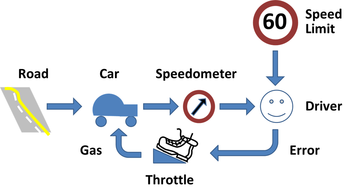Feedback: Difference between revisions
imported>John R. Brews (→Example: FYI) |
imported>John R. Brews (→Example: another example) |
||
| Line 3: | Line 3: | ||
'''Feedback''' is an alteration of the input to a system based upon a monitored internal state that changes the input either to modify that state (positive feedback), or to maintain it (negative or degenerative feedback). Unlike ''feedforward'' control, which anticipates a need for change, ''feedback'' introduces change only as a response to a disturbance.<ref name=Seborg/> | '''Feedback''' is an alteration of the input to a system based upon a monitored internal state that changes the input either to modify that state (positive feedback), or to maintain it (negative or degenerative feedback). Unlike ''feedforward'' control, which anticipates a need for change, ''feedback'' introduces change only as a response to a disturbance.<ref name=Seborg/> | ||
== | ==Examples== | ||
{{Image|Car feedback.png|left|350px|Keeping a car at the speed limit.}} | |||
{{Image|Thermostat system.png|right|350px|Thermostatic control of house temperature using a negative feedback system.}} | {{Image|Thermostat system.png|right|350px|Thermostatic control of house temperature using a negative feedback system.}} | ||
The | An everyday example of negative feedback to control a system is shown at the left, where a car is maintained at the speed limit by a driver using the throttle (accelerator) to adjust to road conditions. The car's speed is decided by a combination of the road conditions and the gas supplied, and the gas supplied is the system feedback, the amount of which is controlled by the driver who compares the speedometer reading with the speed limit. | ||
A more formal example of negative feedback is the thermostatic control of house temperature.<ref name= Ganesh/> In the figure, the house temperature is a response to the combined heat input from the world and from the furnace. Suppose a change occurs in the heat supplied to the house by the outside world. The resultant house temperature is sensed by a thermometer and converted to an electrical signal. This signal is compared by the thermostat to a set-point signal that corresponds to the desired temperature value. The discrepancy between the set point and the signal is calculated as an error signal by the thermostat, triggering (activating) action by the furnace. Depending upon the sign of the error the furnace produces more or less heat, regulating the combined heat input to the house so the temperature stays constant. In other words, the information on system temperature is used to generate ''feedback'' that keeps the temperature at value. | |||
It might be noted that translation of signals between various forms (such as temperature, chemical signals, electrical signals, mechanical signals) occurs throughout the feedback loop. Also, there are time delays introduced at each step in a feedback loop that affect its success in tracking variations in the world's input. | It might be noted that translation of signals between various forms (such as temperature, chemical signals, electrical signals, mechanical signals) occurs throughout the feedback loop. Also, there are time delays introduced at each step in a feedback loop that affect its success in tracking variations in the world's input. | ||
Revision as of 10:09, 5 June 2014
Feedback is an alteration of the input to a system based upon a monitored internal state that changes the input either to modify that state (positive feedback), or to maintain it (negative or degenerative feedback). Unlike feedforward control, which anticipates a need for change, feedback introduces change only as a response to a disturbance.[1]
Examples
An everyday example of negative feedback to control a system is shown at the left, where a car is maintained at the speed limit by a driver using the throttle (accelerator) to adjust to road conditions. The car's speed is decided by a combination of the road conditions and the gas supplied, and the gas supplied is the system feedback, the amount of which is controlled by the driver who compares the speedometer reading with the speed limit.
A more formal example of negative feedback is the thermostatic control of house temperature.[2] In the figure, the house temperature is a response to the combined heat input from the world and from the furnace. Suppose a change occurs in the heat supplied to the house by the outside world. The resultant house temperature is sensed by a thermometer and converted to an electrical signal. This signal is compared by the thermostat to a set-point signal that corresponds to the desired temperature value. The discrepancy between the set point and the signal is calculated as an error signal by the thermostat, triggering (activating) action by the furnace. Depending upon the sign of the error the furnace produces more or less heat, regulating the combined heat input to the house so the temperature stays constant. In other words, the information on system temperature is used to generate feedback that keeps the temperature at value.
It might be noted that translation of signals between various forms (such as temperature, chemical signals, electrical signals, mechanical signals) occurs throughout the feedback loop. Also, there are time delays introduced at each step in a feedback loop that affect its success in tracking variations in the world's input.
The same principle is found in biology as homeostasis.[3]
References
- ↑ Dale E. Seborg, Duncan A. Mellichamp, Thomas F. Edgar, Francis J. Doyle, III (2010). “§15.1 Introduction to feedforward control”, Process Dynamics and Control. John Wiley & Sons, pp. 274 ff. ISBN 9780470128671.
- ↑ Rao Ganesh (2010). “Feedback control”, Control engineering. Pearson Education India, pp. 29 ff. ISBN 9788131732335.
- ↑ See, for example, Lauralee Sherwood (2005). Fundamentals of Physiology: A Human Perspective, 3rd ed. Cengage Learning, p. 14. ISBN 9780534466978.

